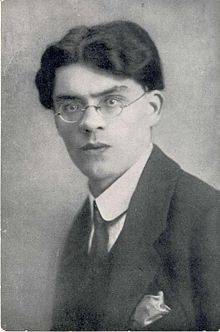Marij Kogoj

Marij Julij Kogoj (Trieste, 20 September 1892[1] – Ljubljana, 25 February 1956) was a Slovenian composer and writer of Italian birth. He is noted for his expressionist music, including the opera Črne maske (Black Masks), work that was well received in 1920s Slovenia amid a flowering of avant-garde artistic, cultural, and political movements. As a young man, he studied with Franz Schreker and then Arnold Schoenberg. In 1932, schizophrenia ended his career prematurely. His music and milieu is receiving renewed attention in the 21st century, but he remains little known internationally.
Biography and music
Kogoj was born an orphan in Trieste, where he was misidentified as his deceased brother Marij (27 April 1895 – 31 January 1896).[2] In 1910, he began composing as a self-taught musician while at school in Gorizia (1907–1914).[2] He studied counterpoint and composition with Franz Schreker at the Vienna Music Academy (1914–1917) and then continued his studies with Arnold Schoenberg at Eugenie Schwarzwald's school (1918).[3] In 1919, he married Marija Podlogar.[4]
Among the Slovenian avant-garde, Kogoj was an especially prominent figure between 1919 and 1922.[2] He performed his own music as part of the September 1920 Novomeška pomlad (Novo Mesto Spring), an exhibition sponsored by Fran Windischer and painter Rihard Jakopič in Novo Mesto that brought together many avant-garde artists such as futurist poet Anton Podbevšek, painter Božidar Jakac, singer Zdenka Zikova, and poet Miran Jarc.[5] This gathering is considered to be the beginning of the avant-garde in Slovenia.[6] It arose from nascent futurist and constructivist artistic activity in the region, often with some left-wing political affinity.[7][a]
In 1922, Podbevšek, Kogoj, and theater critic Josip Vidmar issued a journal named Trije labodje (Three Swans) after the example of Der Blaue Reiter.[8] Veno Pilon painted Kogoj in The Portrait of the Composer Marij Kogoj (1923), an oil on canvas now at the Museum of Modern Art, Ljubljana. Polona Tratnik wrote that Pilon captured Kogoj's "eccentricity and enigmatic nature"—perhaps signs of his later mental illness, she speculated.[9]
He spent most of his life in Ljubljana, where he was a music critic.[2] He was also a répétiteur at the Slovenian National Theatre Opera (1924–1932).[2] For a time, he wrote expressionist music[6] and enjoyed immense national popularity.[10][11] Kogoj's late 1920s opera Črne maske (Black Masks) was an artistic success[12] and is his most prominent work.[6] Vidmar compared it to Alban Berg's Wozzeck as another notable expressionist opera he knew.[13]
Kogoj's career ended abruptly with a 1932 schizophrenia diagnosis.[2] He remained institutionalized until his death in 1956.[14] His plans for a systematic approach to atonal harmony via "chord permutations", which anticipated the compositional procedures of Schoenberg and Josef Matthias Hauer, remained unfinished.[2] Like many artists of Slovenian avant-garde circles, he is now little known.[15]
Discography and performances
Discography
- Complete Works for Violin & Piano, Črtomir Šiškovič (violin) and Emanuele Arciuli. (Stradivarius, 2000)
Performances
- Črne maske (Black Masks), performed January 2012[16]
References
Notes
- ^ Subsequent Slovenian avant-garde circles, a second and third, formed around poet Srečko Kosovel in the early 1920s and then painter Avgust Černigoj in Trieste during the middle of the 1920s.[6] There were no other Slovenian avant-garde circles until the 1960s Skupina OHO.[6]
Citations
- ^ Slovenski biografski leksikon: Marij Kogoj (in Slovene)
- ^ a b c d e f g Loparnik and Klemenčič 2001, ¶1.
- ^ Loparnik and Klemenčič 2001, ¶1; Tratnik 2024b, 72.
- ^ Sadie, Julie Anne; Sadie, Stanley (2005). Calling on the Composer: A Guide to European Composer Houses and Museums. New Haven, CT: Yale University Press. p. 225.
- ^ Tratnik 2024a, 2; Toporišič 2024, 127.
- ^ a b c d e Tratnik 2024b, 72.
- ^ Toporišič 2024, 124–127.
- ^ Tratnik 2024b, 72; Toporišič 2024, 125, 125n4.
- ^ Tratnik 2024b, 73.
- ^ Čuk, S. (2016). "Obletnica meseca". Ognjišče. 2016 (2): 52. Retrieved February 7, 2024.
- ^ Opera, power and ideology: anthropological study of a national art p97 Vlado Kotnik - 2010 -"The interwar generation of Slovenian opera composers was characterized by an eclectic range of styles, from Romanticism to modernism. The 1920s were dominated by the Expressionist composer Marij Kogoj, a pupil of Schoenberg"
- ^ Opera, power and ideology: anthropological study of a national art p97 Vlado Kotnik - 2010
- ^ Tratnik 2024b, 72, quoting Josip Vidmar's 1985 Obrazi (62).
- ^ zavod-parnas.org. "Marij Kogoj". www.gradez.si. Archived from the original on 2017-04-12. Retrieved 2016-05-06.
- ^ Tratnik 2024a, 3.
- ^ SNG Maribor Archived 2011-09-11 at the Wayback Machine
Bibliography
- Compendia
- Toporišič, Tomaž. 2024. "Trieste–Ljubljana–Zagreb–Belgrade". The European Avant-Garde—A Hundred Years Later, ed. and intro. Polona Tratnik, 124–142. Vol. 1, Transcultural Aesthetics, gen. ed. Manfred Milz. Leiden and Boston: Brill. ISBN 978-9-00-468587-1 (ebk). ISBN 978-9-00-468586-4 (hbk). doi:10.1163/9789004685871_007.
- Tratnik, Polona. 2024. "Introduction: the Turning and Returning of the Avant-Garde". The European Avant-Garde—A Hundred Years Later, ed. and intro. Polona Tratnik, 1–14. Vol. 1, Transcultural Aesthetics, gen. ed. Manfred Milz. Leiden and Boston: Brill. ISBN 978-9-00-468587-1 (ebk). ISBN 978-9-00-468586-4 (hbk). doi:10.1163/9789004685871_002.
- Tratnik, Polona. 2024. "A Quest for Avant-Garde: Doing Avant-Garde, Inheriting Avant-Garde". The European Avant-Garde—A Hundred Years Later, ed. and intro. Polona Tratnik, 63–98. Vol. 1, Transcultural Aesthetics, gen. ed. Manfred Milz. Leiden and Boston: Brill. ISBN 978-9-00-468587-1 (ebk). ISBN 978-9-00-468586-4 (hbk). doi:10.1163/9789004685871_005.
- Encyclopedias
- Loparnik, Borut. 2001. "Kogoj, Marij", rev. and upd. Ivan Klemenčič (13 January 2015). Grove Music Online. Digitally published 2001. Retrieved 23 August 2024. doi:10.1093/gmo/9781561592630.article.15260. (subscription or UK public library membership required)

